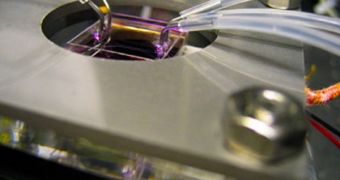A collaboration of investigators at the Massachusetts Institute of Technology (MIT), in Cambridge, announces the development of a new liquid processing methods for controlling the shape of nanoscale wires. This approach could soon allow experts to produce complete electronic devices in one go.
This technology only works on wires deposited from a solution at this point, but it does enable experts to produce fully-functional electronic devices via a liquid-based process. Over the past few years, nanotechnology has proven itself to be the research field of the future on countless occasions.
In their latest experiments, the MIT scientists used a single beaker filled with zinc oxide nanowires to produce a functional light-emitting diode (LED). With other approaches, creating the same thing would have required several steps and numerous lab instruments.
Additional, producing LED devices in the past required that the mixture of materials be placed in vacuum, and under specific sets of temperatures. The new approach allows experts to create LED, and conceivably other electronic devices as well, at room temperature.
“For nanostructures, there’s a coupling between the geometry and the electrical and optical properties. Being able to tune the geometry is very powerful,” says MIT postdoctoral researcher Brian Chow.
The expert is also a coauthor of a new research paper describing the innovative investigation. The work was detailed in the July 10 issue of the top scientific journal Nature Materials. The novel approach can produce all types of nanowires, from flat plates to long thin wires.
“People have done a good job of controlling the morphology of wires by other means – using high temperatures, high pressure, or subtractive processing. But to be able to do this under these benign conditions is attractive,” Chow explains.
The key to the success of this investigation was the fact that zinc oxide has some odd electrostatic properties. As the material grows in a solution, these traits change in consistent patterns, that can be predicted and then exploited.
In the near future, this new technology could innovate medicine, helping researchers create new and advanced neural implants, that would cause no immune response in the body. Other devices, for testing, analysis and diagnostics, could also be made possible.
The new investigation was funded by the MIT Center for Bits and Atoms, the MIT Media Lab, the Korea Foundation for Advanced Studies, Samsung Electronics, the Harvard Society of Fellows, the Wallace H. Coulter Early Career Award, and the NARSAD Young Investigator Award.
Additional funds were provided by the US National Science Foundation (NSF) and the National Institutes of Health (NIH) Director’s New Innovator Award.

 14 DAY TRIAL //
14 DAY TRIAL //